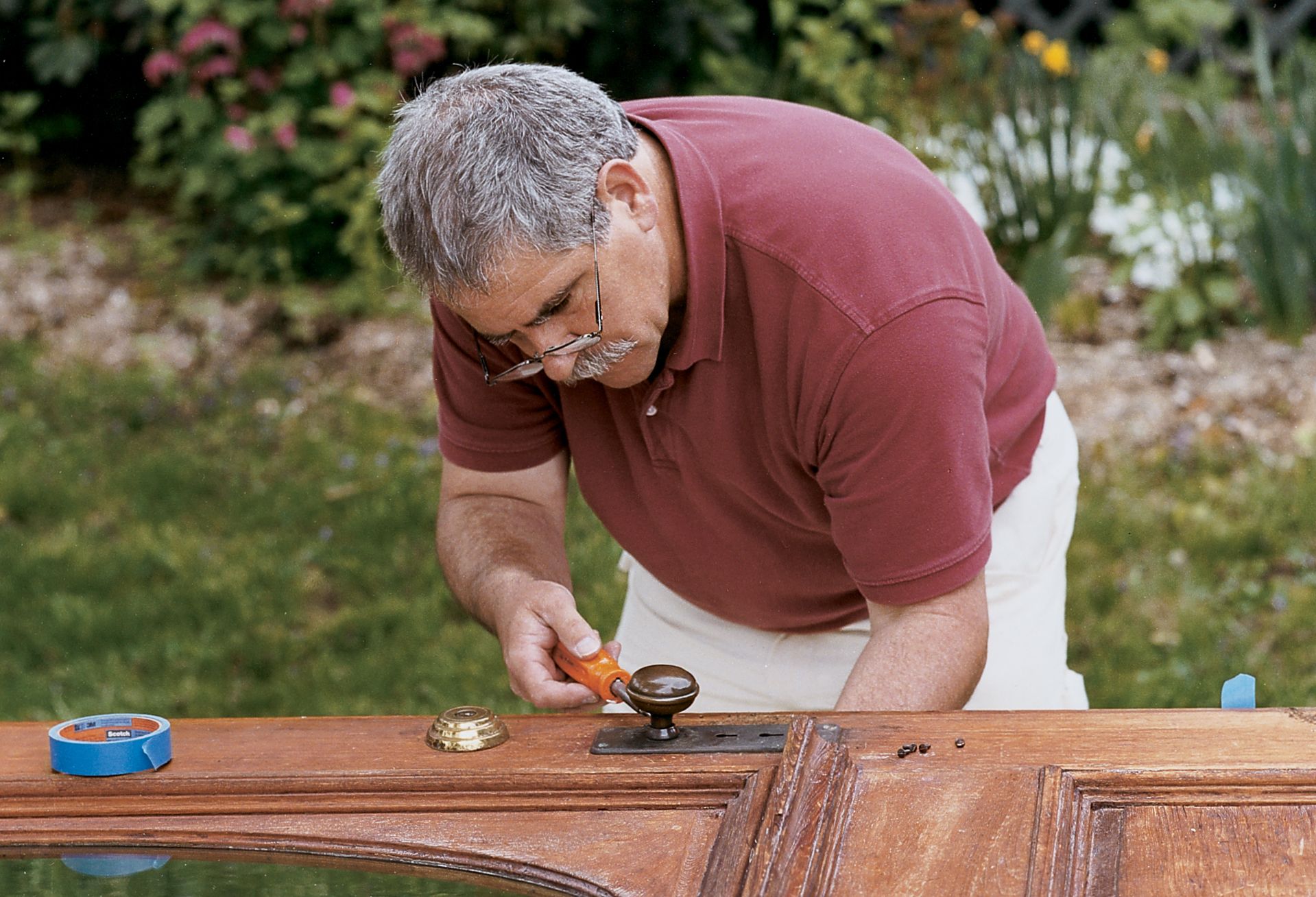Project details
Skill
Cost
Estimated Time
Most high-quality wood doors don’t need to be replaced after a few years of exposure to the elements—they can be refinished. This involves removing the old finish from the door and applying a new one to enhance its appearance and protect it from wear and tear. Though the project requires patience and attention to detail, you can restore your wood door with some DIY work and a few tools. In this guide, we’ll walk you through the steps to refinish a wood door and provide tips and tricks for getting the best-looking results on your own entryway.
Restoring an Antique Door
The years and the elements hadn’t been kind to the exterior of Belinda Chase and Scott Oja’s 94-year-old, thick cypress door. Flakes of varnish still clung to the wood in spots, while the rest of the surface was rough and dried out from the effects of water and sun. But Chase and Oja were determined to save this door—they knew the value of the antique, with its oval light of rippled, mouth-blown glass and its sturdy, all-wood construction. So they hired painting contractor John Dee to bring it back to life.
Dee, who has worked on many This Old House television projects, attacked the splotchy surface with sandpaper and scrapers until the old door was as fresh and as fragrant as the day it was built. By mid-afternoon, the door was ready for its new finish—a high-performance, oil-based varnish to highlight the wood’s rich color and grain. Three coats later, it gleamed like aged mahogany. “I can’t believe it’s the same door,” said Chase. “It’s just so beautiful.”
Below, Dee shares tips and instructions to achieve the same results.
Tools and Materials Needed
Before you begin, gather all the necessary tools and materials.
Essential Tools
- Screwdriver (for removing hardware)
- Random-orbit sander
- Sandpaper (80-grit, 100-grit, 120-grit, 220-grit, 280-grit)
- Scrapers (trapezoid and teardrop shapes)
- China-bristle brush
- Sanding sponge
- Vacuum cleaner
- Tack cloth
- Padded sawhorses
- Bucket
 Sawhorses
Sawhorses Random orbit sander
Random orbit sander Scrapers
Scrapers Shop vacuum
Shop vacuum Paintbrushes
Paintbrushes
Required Materials
- Wood filler (if needed for repairs)
- Paint thinner
- High-performance, oil-based varnish or exterior-grade finish
- Clean rags
- Protective gear (gloves, safety glasses, dust mask)
Choosing the Right Door Finish
Picking the right finish is essential for both the appearance and longevity of your refinished door. Knowing the different types will help you make the best choice for your project.
Paint vs. Clear Finish
Nothing beats paint for practicality. Two coats of enamel paint over a primer will provide a wood door with the best and longest-lasting protection against sun, abrasion, and weather—about 8 to 10 years. But a beautiful wood door with a clear finish will attract many more admiring glances, as long as you maintain it with devotion.
A clear finish typically needs a thorough sanding every few years to remove its sun- and weather-damaged top layers, followed by a couple of fresh top coats. Neglect it, and the base coat will eventually lose its grip, leaving you with a graying, peeling mess. At that point, a complete refinishing is your only option. If you prefer a low-maintenance door, choose an exterior enamel paint.
Types of Wood Finishes
If you opt for a clear finish like polyurethane or varnish instead of paint, here are your choices:
- Oil-based varnishes: Durable and provide a rich, warm glow
- Water-based polyurethanes: Easy to apply and clean up, with low odor
- Penetrating oils: Enhance the natural beauty of the wood grain
Spar varnish has long been the finish of choice for exterior wood because of its elastic toughness and ability to stand up to the sun. But now many different and effective formulations have made it to store shelves. Look for one specifically for outdoor use and loaded with UV-protection. Dee used Sikkens’ Cetol Door & Window on this project. Then, follow the application instructions and maintenance regimen carefully.
How To Refinish a Wood Door
1. Prepare the Door for Refinishing
Proper preparation is crucial for achieving a smooth, long-lasting finish. Choose a well-ventilated area, preferably outdoors or in a garage with open doors. Set up padded sawhorses to support the door and protect it from damage. Ensure you have adequate lighting to see imperfections in the wood surface.
Start by removing all hardware from the door, including hinges, doorknobs, and any decorative elements. This step prevents damage to the hardware and ensures a thorough refinishing job. Label each piece as you remove it to make reassembly easier later.
2. Strip the Old Finish
For the new finish to adhere to the wood, you’ll need to remove the old finish with sanding or chemical strippers, depending on the door’s condition and the type of existing finish. You’ll also need finer tools to get into profiles and moldings.
Sanding Techniques
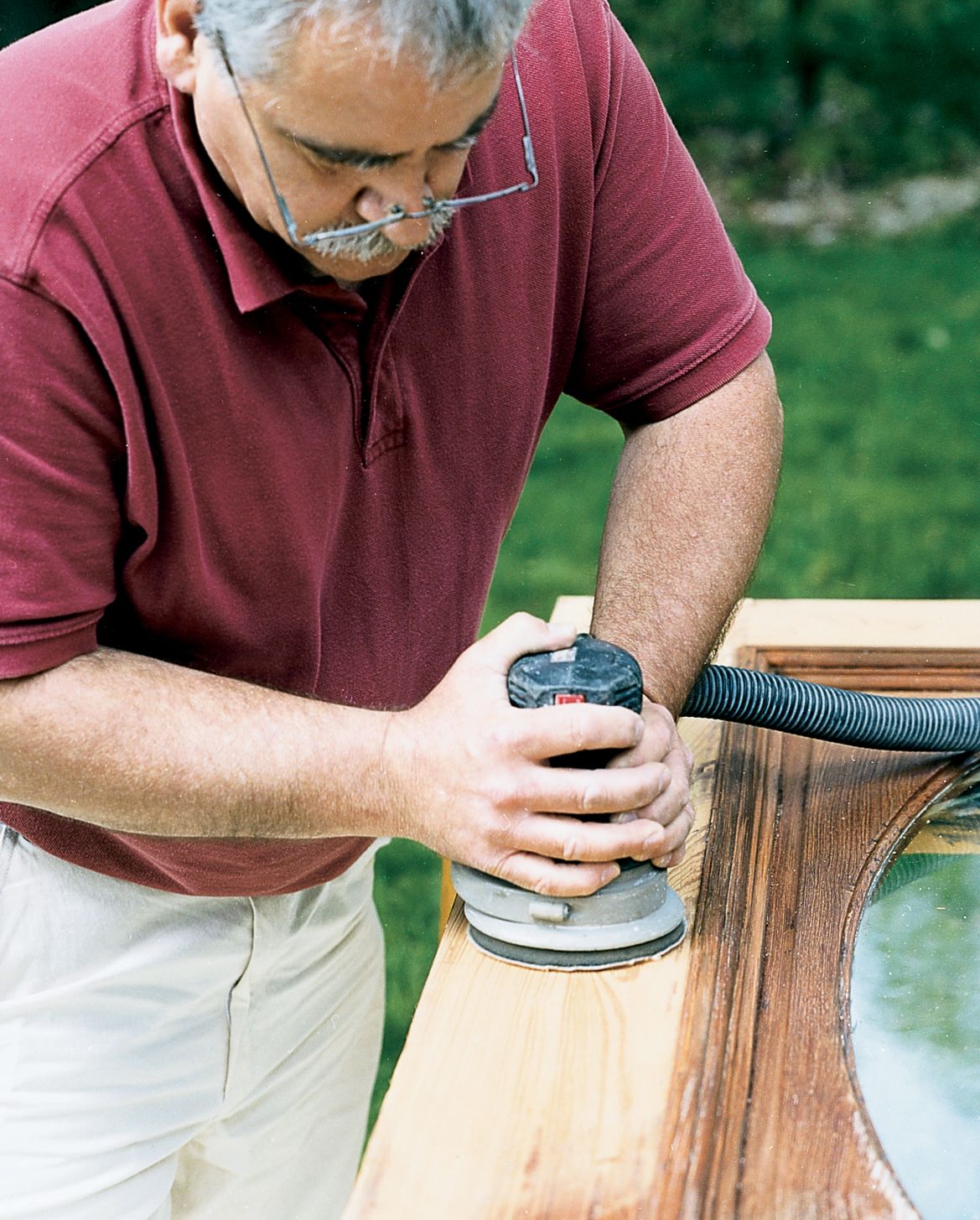
For doors with a thin layer of varnish or paint, sanding is often sufficient. With the door resting on padded sawhorses, use a random-orbit sander with 80-grit paper to quickly remove what remains of the old varnish and sun-baked flakes of wood.
Sand the wood again with 100-grit paper, then 120-grit. “There’s no sense in going any finer,” Dee says. If you do, you’ll begin to close off the pores in the wood, which will prevent the finish from adhering to the surface.
Using Chemical Strippers
For doors with multiple layers of paint or varnish, chemical strippers may be necessary. Apply the stripper according to the manufacturer’s instructions, and use a scraper to remove the loosened finish. Always work in a well-ventilated area and wear protective gear when using chemical strippers.
Scraping Moldings
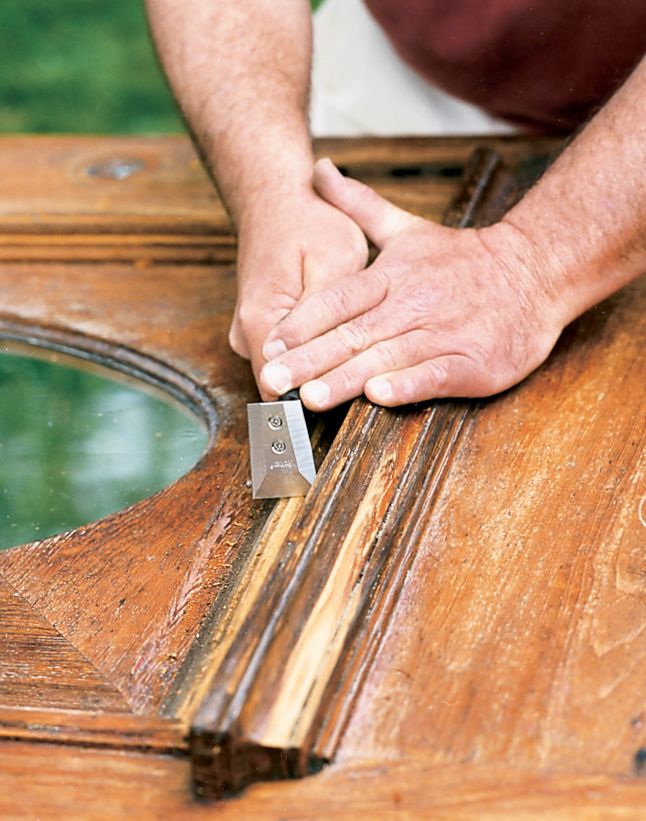
Small, razor-sharp scrapers reach into corners, across narrow profiles, and on the end grain of raised panels where no rotary sander can safely go. Pull the scraper with the grain—use two hands and apply only gentle downward pressure to reduce the chance of an accidental slip gouging the wood. Dee uses two blade shapes, a trapezoid for the flats and a teardrop for the narrow crevices.
Hand-Sanding Profiles
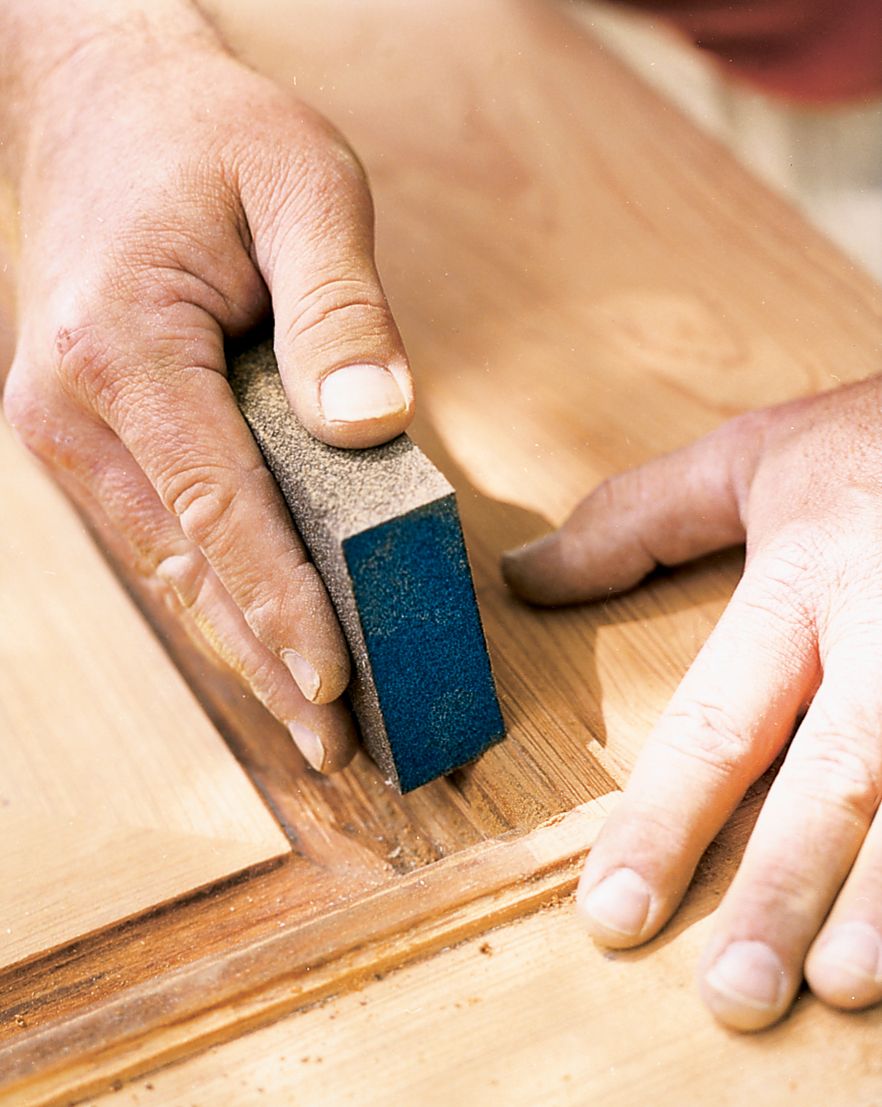
Fold a half sheet of 100-grit sandpaper in thirds, press it into a section of the profile with your fingertips, and then rub back and forth in long strokes over the length of the molding. Use a sanding sponge, as above, on inside corners where fingers can’t reach. Follow with a quick brushing and a thorough vacuuming to clear away dust that might mar the finish.
3. Repair Any Damage
Before applying a new finish, it’s important to address any damage to the door’s surface. For minor dents and scratches, use wood filler to fill in the imperfections. Once dry, sand the filled areas flush with the surrounding wood. For deeper gouges, use a two-part epoxy wood filler for added strength.
If the door has warped over time, you may need to plane the edges to ensure it fits properly in the frame. This is a more advanced repair that might require professional assistance if you’re not comfortable with the process.
4. Finish Edges and Rehang
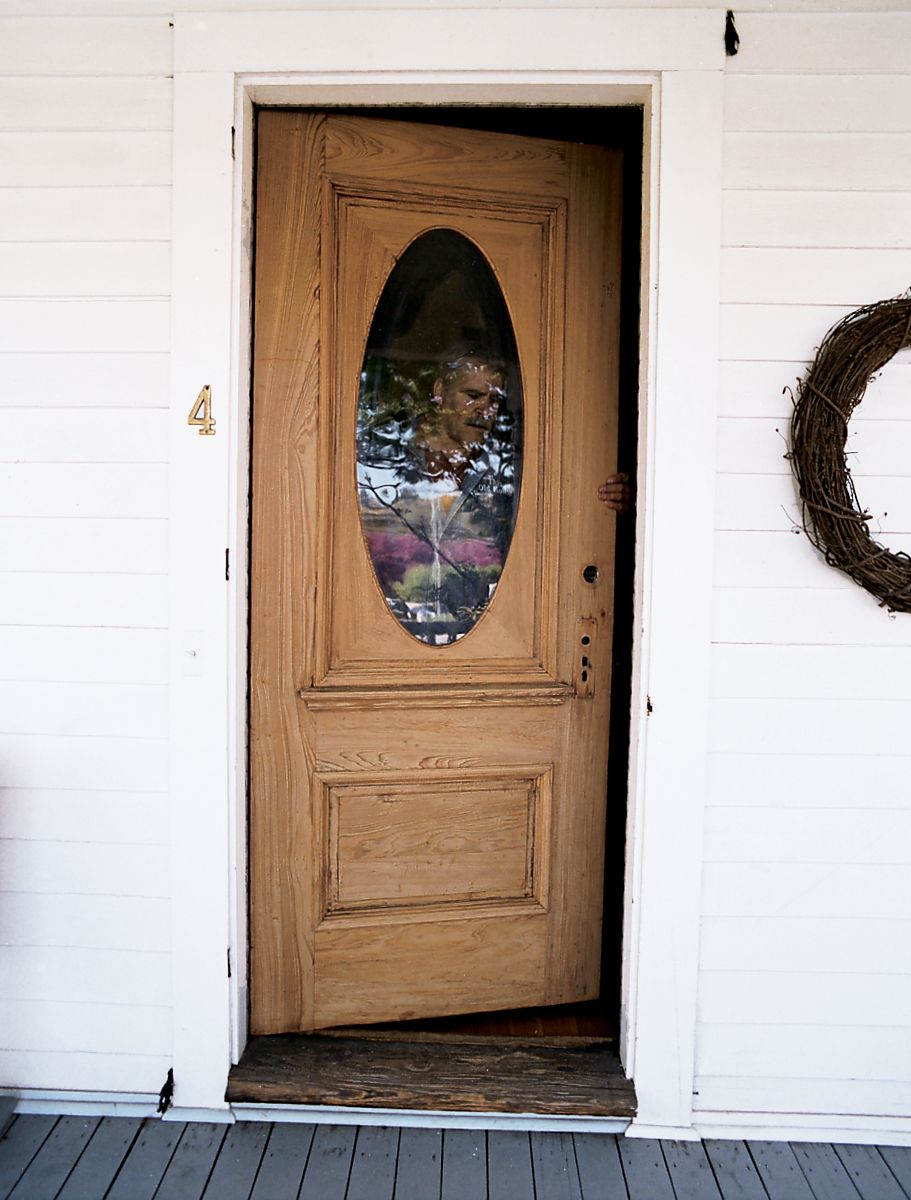
While it’s still on the sawhorses, seal the door’s bottom and top edges with a coat of finish. Then put the door back on its hinges before applying the first coat. Otherwise, there’s no practical way to rehang the door without damaging the finish.
5. Apply the New Finish
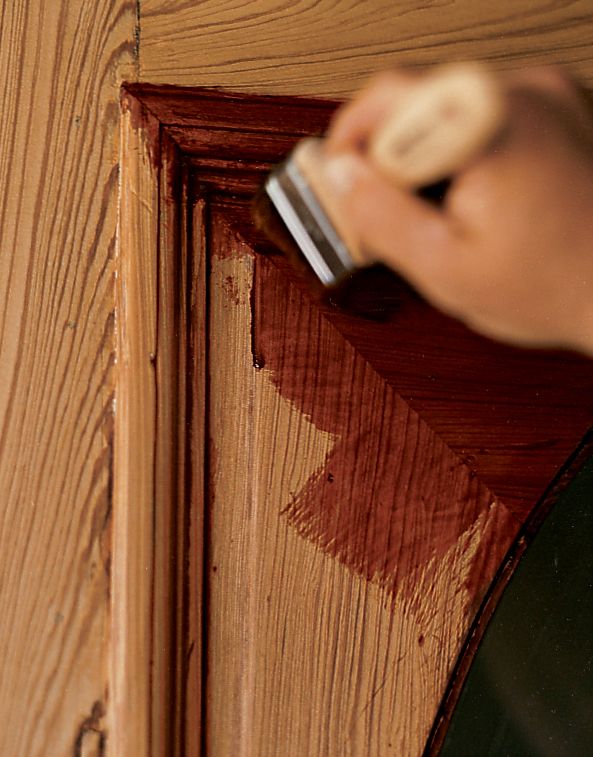
With the door prepared and the finish selected, it’s time to apply the new finish. If you’re staining the door before applying a clear finish, use a clean cloth or brush to apply the stain evenly. Work in the direction of the wood grain and wipe off any excess stain promptly to avoid blotching.
When applying varnish, use a high-quality brush and work in long, smooth strokes. Here are the steps Dee used for this process.
- Soak a new China-bristle brush for a minute or two in paint thinner, then spin or knock off the excess.
- Pour some finish into a clean bucket and dip the bristles about a third of the way into the liquid.
- Start on the panels, then move to the surrounding moldings.
- Coat the horizontal rails next, and finally the vertical stiles.
- If any finish ends up on a dry surface out of sequence, wipe it off immediately with a rag.
6. Allow the Finish to Dry Overnight
Proper drying and curing are essential for a durable finish that will stand the test of time. Allow the door to dry overnight before closing it completely, and do your best to promote good air circulation. Avoid direct sunlight or high humidity, as these can affect the drying process.
7. Apply a Final Coat and Reinstall Hardware
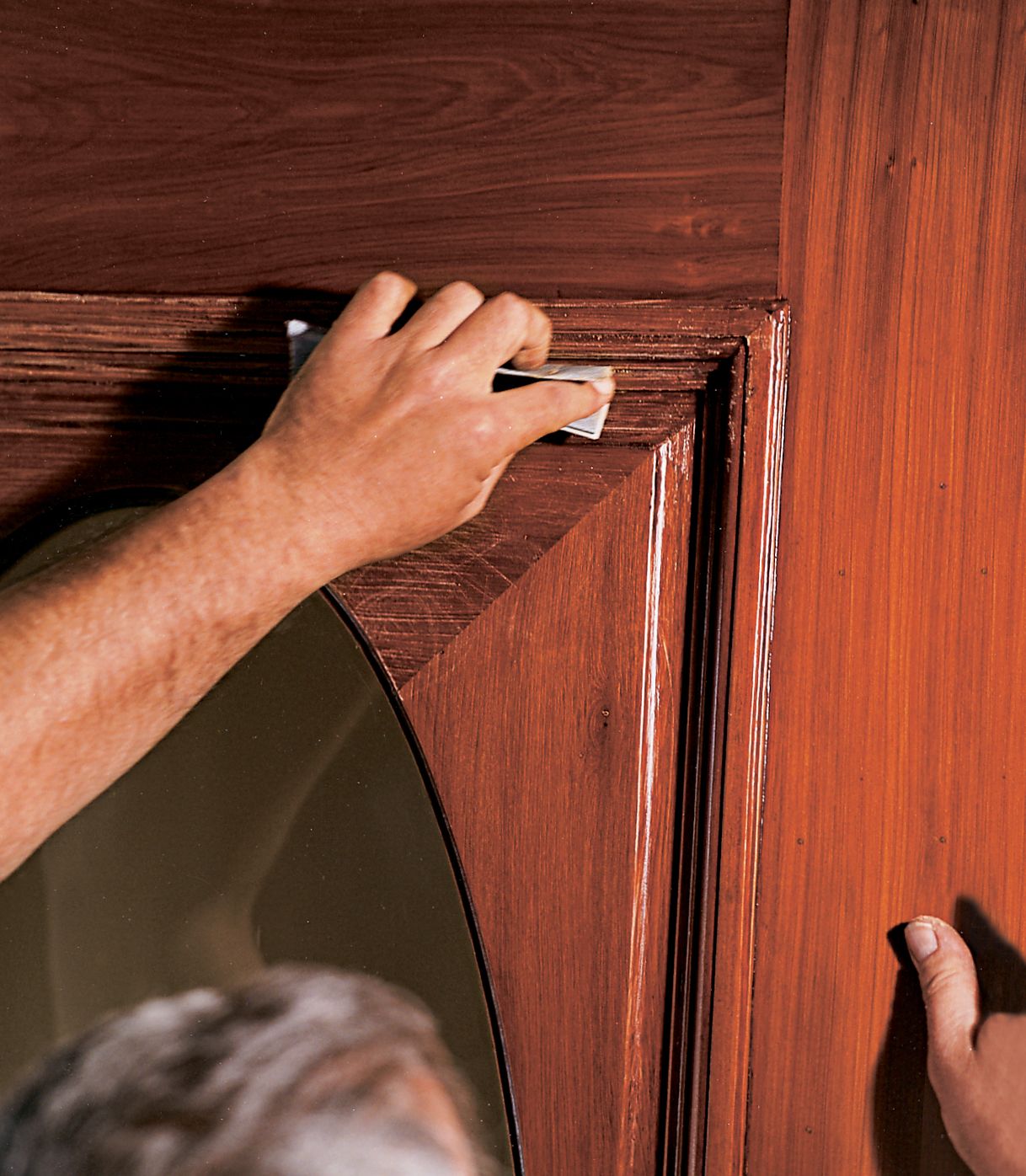
After the finish has dried overnight, gently hand-sand it with 220-grit paper—you don’t want to sand through to bare wood. Dust the door and wipe it down with a tack cloth. Brush on the second coat, following the same order, and let it dry overnight.
Dust and sand with 280-grit paper, then put on the final coat, once again leaving it to dry overnight. When that’s dry, reattach the door hardware. Carefully reinstall all components, ensuring everything is properly aligned and functioning smoothly.
While the finish may feel dry to the touch after a day, full curing can take up to a week or more. During this time, avoid exposing the door to heavy use. If it’s your front door, you may not be able to avoid closing it completely, but be gentle with it for the first week.
Troubleshooting Common Refinishing Issues
Even with careful application, issues can sometimes arise during the refinishing process. Here’s how how to address common problems.
Dealing with Bubbles or Streaks
If you notice bubbles or streaks in the dried finish, lightly sand the affected area and reapply the finish. Ensure you’re working in optimal conditions—good lighting and ventilation, starting with clean, sanded wood—to prevent these issues.
Fixing Uneven Color
For uneven color, you may need to strip the finish and start over, paying careful attention to even application of stain and finish coats.
When To Hire a Professional
While refinishing a door can be a satisfying DIY project, there are times when it’s best to call in a professional. Here are some of those times.
- The door is severely damaged or warped.
- You’re dealing with a valuable antique door.
- You lack the time or tools to complete the project properly.
- You’re uncomfortable working with chemical strippers or power tools.
Professional refinishers have the experience and equipment to handle complex jobs and can often achieve superior results on challenging projects.
Cost Considerations for Refinishing a Door
Understanding the potential costs involved in refinishing a door can help you budget appropriately for the project. Doing it yourself can save money, but professionals can get the job done quicker and save you the effort.
DIY Costs
When tackling the project yourself, consider the costs of materials and tools, including sandpaper, wood filler, paint thinner, brushes, and varnish. Depending on what you already have at home, you might spend anywhere from $75 to $150 on supplies.
Professional Refinishing
Hiring a professional to refinish your door can vary widely in cost, depending on the door’s condition, the complexity of the job, and your location. On average, professional refinishing jobs can range from $135 to $300.* Though the cost is higher, the investment can be worth it for intricate or antique doors or for a seamless-looking finish.
*Cost data sourced from contractor estimates used by Angi.
Environmental Considerations When Refinishing a Door
While refinishing an old door is generally better for the environment than buying a new one, the process also involves environmental considerations, especially when using chemical strippers and oil-based finishes. Be mindful of the products you use and dispose of waste responsibly.
Eco-Friendly Products
Consider using eco-friendly strippers and finishes that emit fewer VOCs (volatile organic compounds). These products are less harmful to the environment and better for your health. They might cost a bit more but are worth the investment in sustainability.
Waste Disposal
Properly dispose of any solvent-soaked rags and leftover chemicals. Many communities have specific disposal guidelines for household hazardous waste, so check with your local waste management services. Avoid pouring chemicals down the drain or throwing them in the regular trash.
Enhancing Curb Appeal With Your Refinished Door
A freshly refinished door can significantly boost your home’s curb appeal. The entrance is often the first thing visitors notice, and a well-maintained door makes a lasting impression.
Adding Decorative Elements
After refinishing, consider adding new hardware or decorative elements to further enhance the door’s appearance. A stylish doorknob, knocker, or house numbers can complement the new finish and give your entryway a refreshed look.
Complementing Your Home’s Exterior
Choose a finish color that complements your home’s exterior. A carefully selected stain or paint color can tie together other design elements like your front porch, landscaping, and exterior siding, creating a cohesive look.
Extending the Life of Your Refinished Door
To keep your refinished door looking its best, perform regular maintenance and take protective measures.
Regular Maintenance
Clean the door regularly with a soft, damp cloth to remove dust and dirt. Avoid using harsh chemicals or abrasive cleaners that could damage the finish. For minor scratches or wear, lightly sand the affected area and apply a thin coat of finish. For more significant damage, you may need to repeat the refinishing process on the affected area.
Seasonal Inspections
Inspect your door seasonally to catch any signs of wear early. Look for areas where the finish might be fading, cracking, or peeling. Early intervention can prevent more extensive damage.
Protective Measures
For exterior doors, consider adding a storm door, awning, or overhang to protect against the elements. This additional layer of protection can help shield the door from harsh weather, UV rays, and moisture, extending the life of your refinishing work.
Applying Additional Sealants
Applying a protective sealant over the finish can provide an extra layer of defense against moisture and UV damage. Reapply the sealant periodically based on manufacturer recommendations to keep your door in top condition.
